Abstract
1. The cardiac and respiratory responses shown by muskrats in both unrestrained and restrained dives have been compared with responses elicited by stimulation of a number of cardio-depressant receptor inputs, in an attempt to determine which are most important in initiating and maintaining diving bradycardia. 2. In unrestrained voluntary dives heart rate fell from 310 +/- 3 to 54 +/- 3 beats min-1 in 1 to 2 sec, which was significantly below that seen in dives by restrained unanaesthetized or anaesthetized animals. 3. Pouring water on the external nares during maintained artificial ventilation caused heart rate to decline to 76 +/- 12 beats min-1 after 1 sec. Flowing water through the internal nares caused apnoea, in the expiratory position, and bradycardia within one third of a second. Heart rate fell to 20 +/- 2 beats min-1, 1 sec after the start of water flow. Substituting saline for water reduced both the apnoeic and cardiac responses. Bilateral section of the maxillary branch of V and the inferior laryngeal (X) nerves completely abolished the cardiac and respiratory response to water flow. 4. Artificial ventilation throughout periods of nasal stimulation with water or saline reduced the bradycardia, although even the saline driven response could not be completely abolished. Lung deafferentation eliminated any direct effect of artificial ventilation on heart rate during nasal stimulation. 5. Lung deflation caused bradycardia within 0.97 +/- 0.17 sec, heart rate falling from 268 +/- 7 to 59 +/- 4 beats min-1. Bradycardia also occurred during maintained lung inflation but it was delayed for a period which varied from 6.8 +/- 1.8 sec at an inflation pressure of 0.5 kPa to 35 +/- 7 sec at 1.5 kPa. 6. Bradycardia caused by nasal water flow or lung deflation was unaffected by bilateral section of the sinus nerve. 7. Artificial ventilation of paralysed muskrats with 5% CO2 in N2 caused bradycardia when Pa, O2 reached 8.4 +/- 0.8 kPa and heart rate declined to 76 +/- 7 beats min-1 at 4 kPa. Bilateral section of the sinus nerve delayed bradycardia until Pa, O2 reached 4.5 +/- 0.5 kPa. 8. These results suggest that the cardiac response to submergence could be the expression of input from three groups of receptors, nasal, lung and carotid chemoreceptors, although it is not clear how they interact with one another to generate the cardiac responses displayed by unrestrained animals during submergence.
Full text
PDF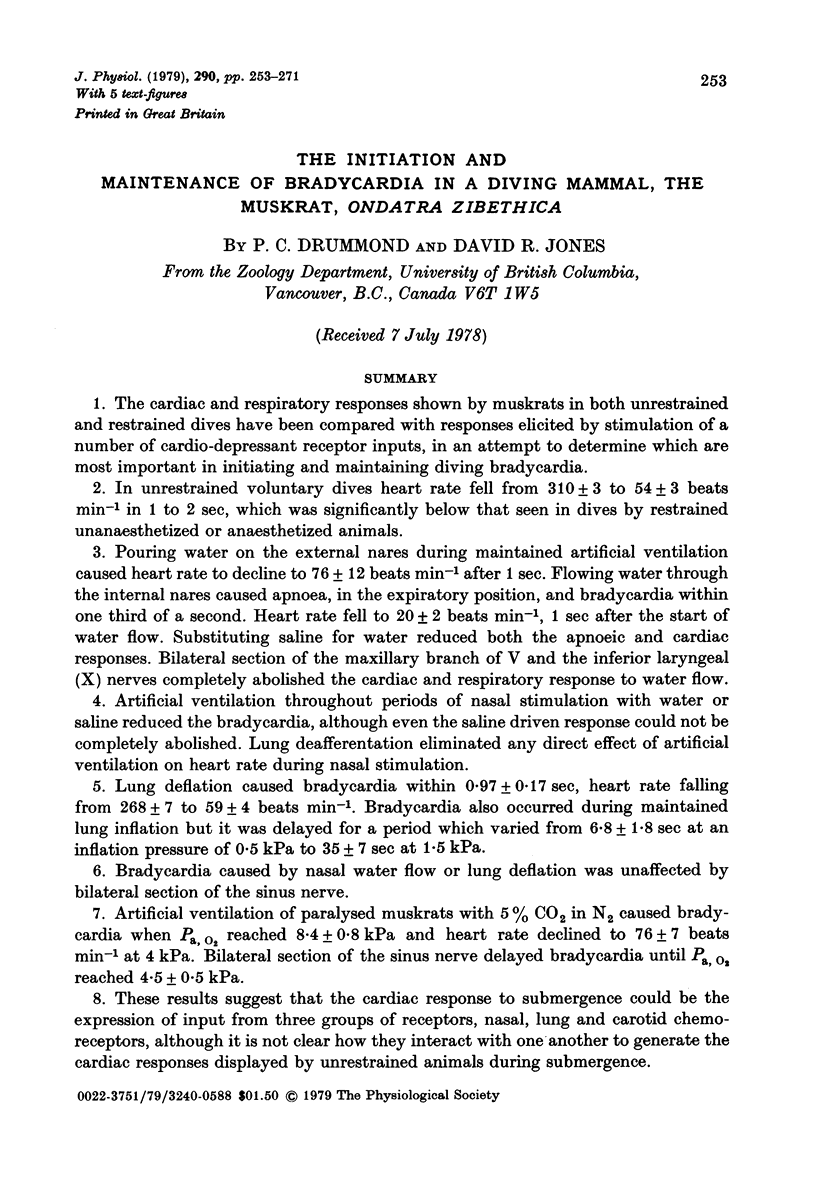

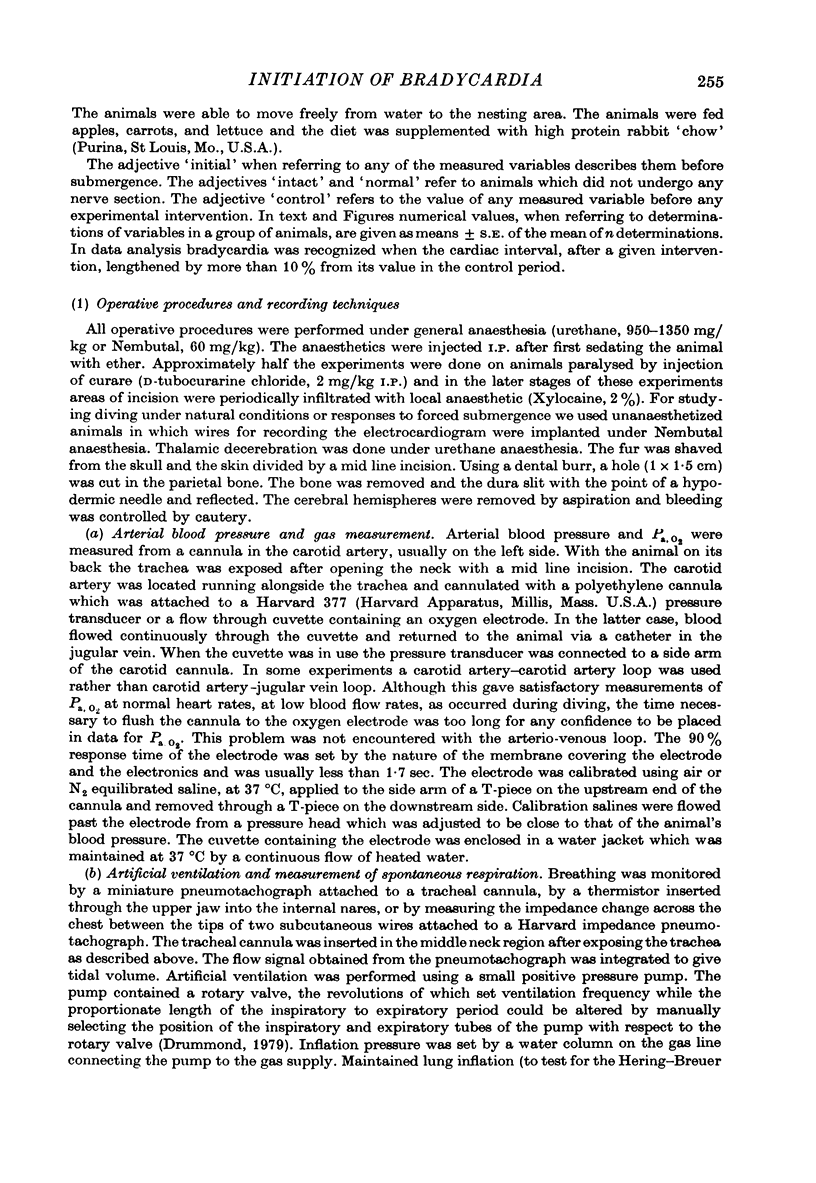

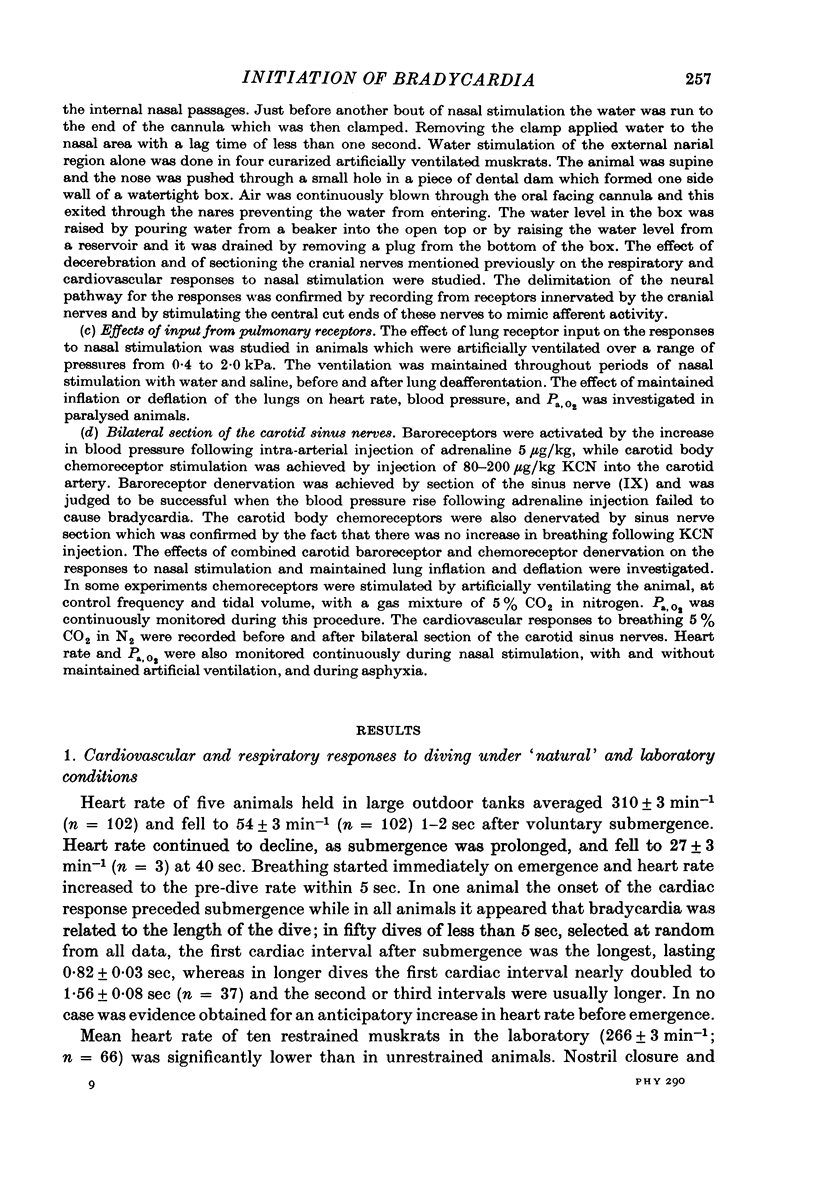
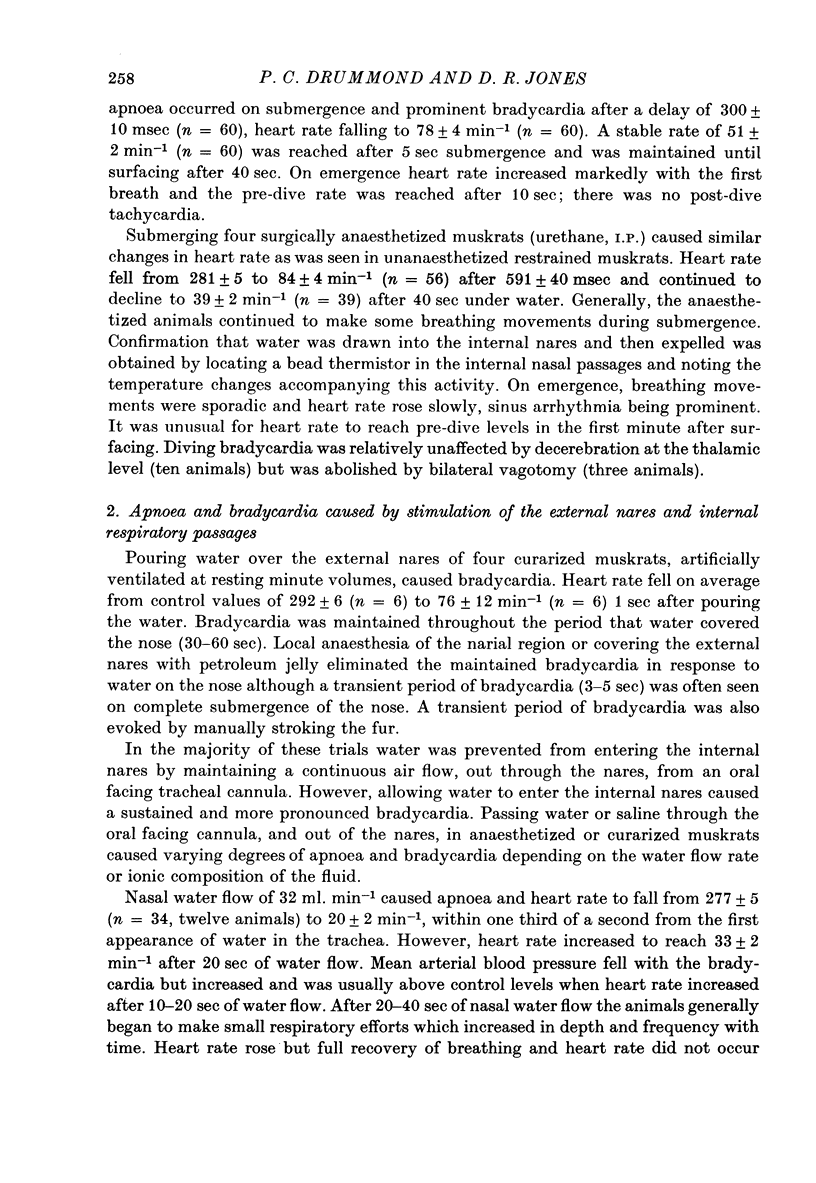
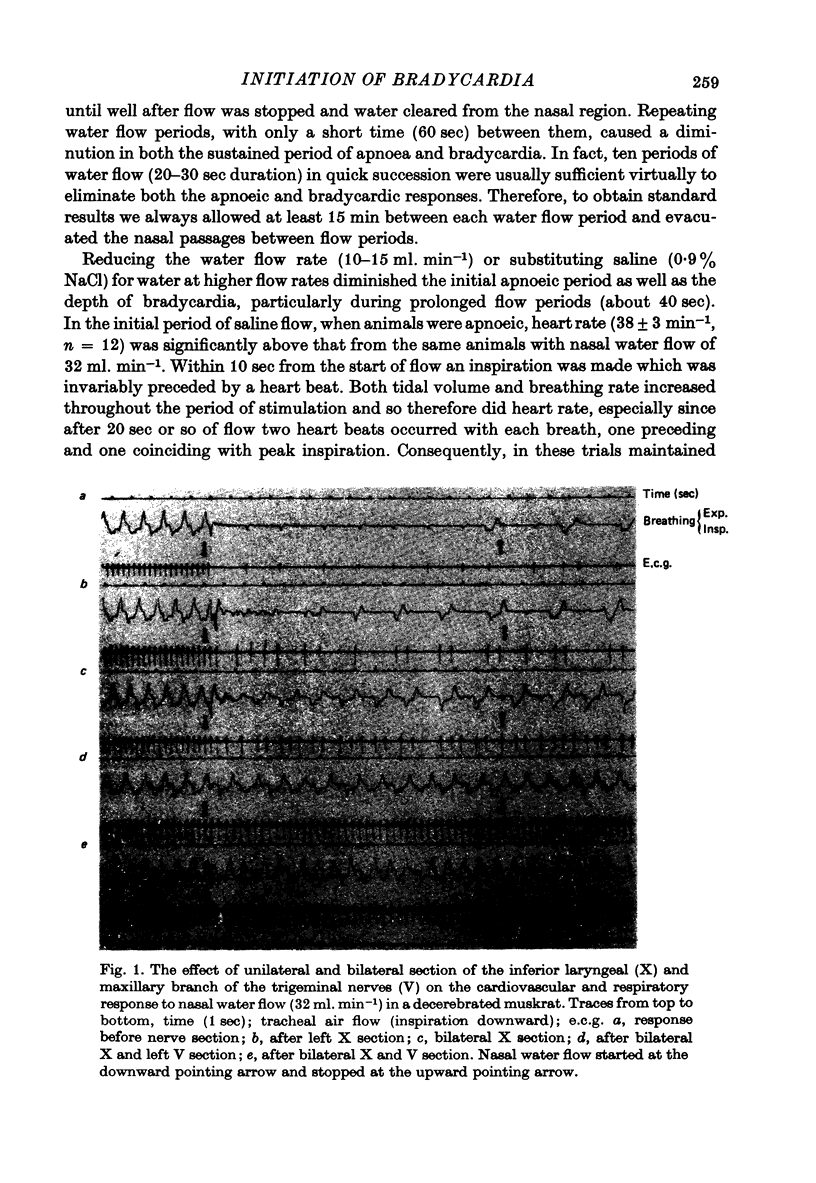


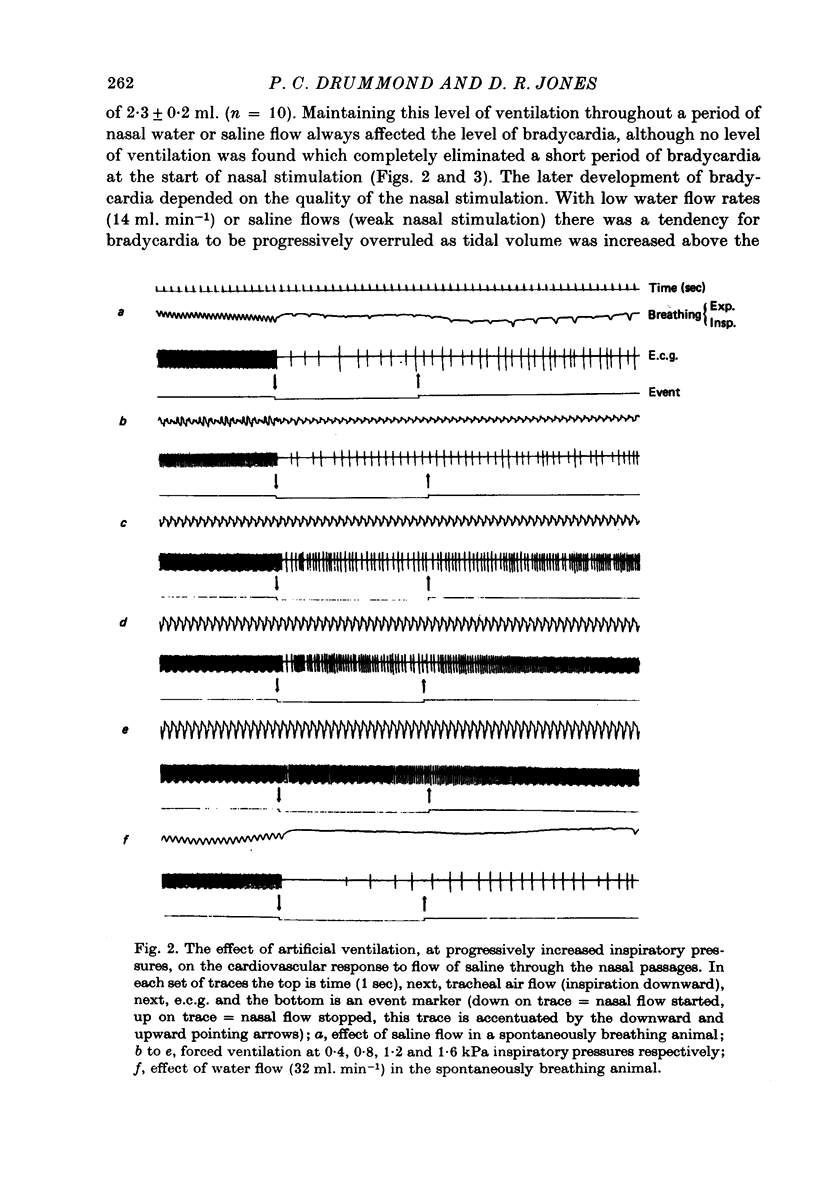

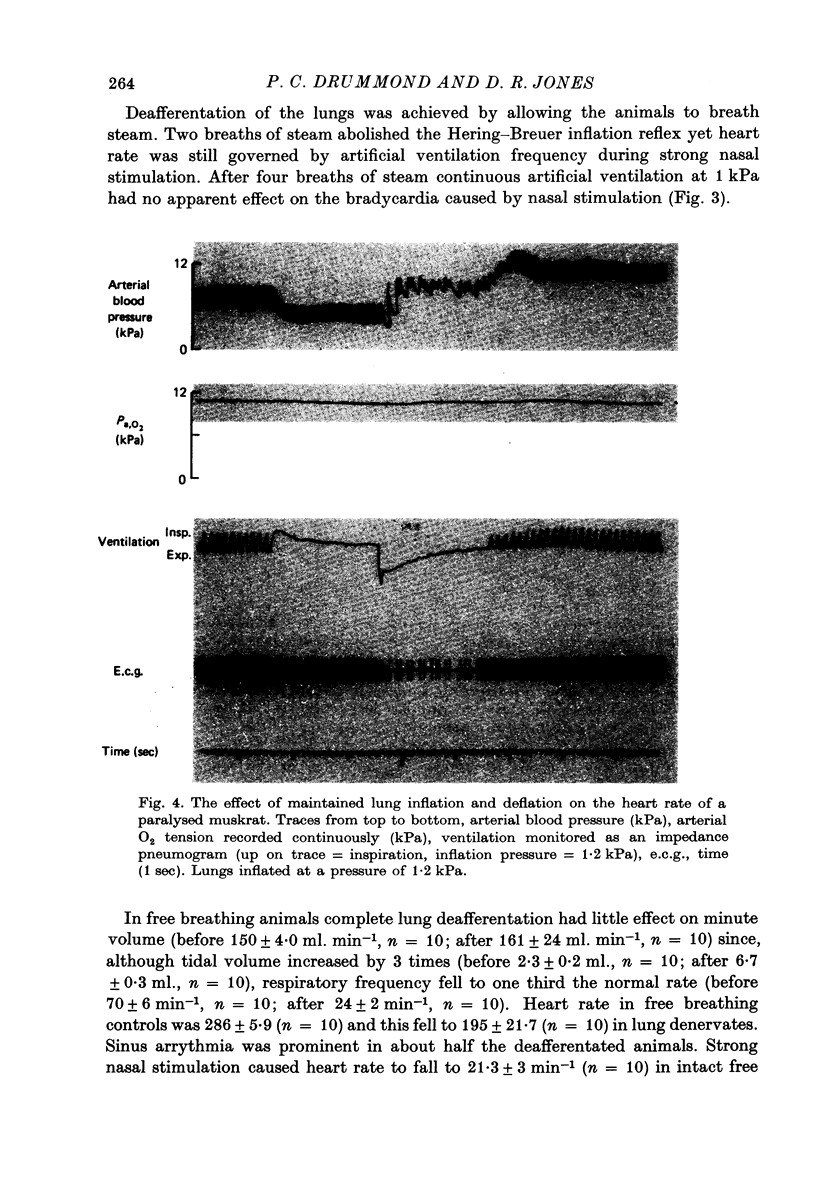

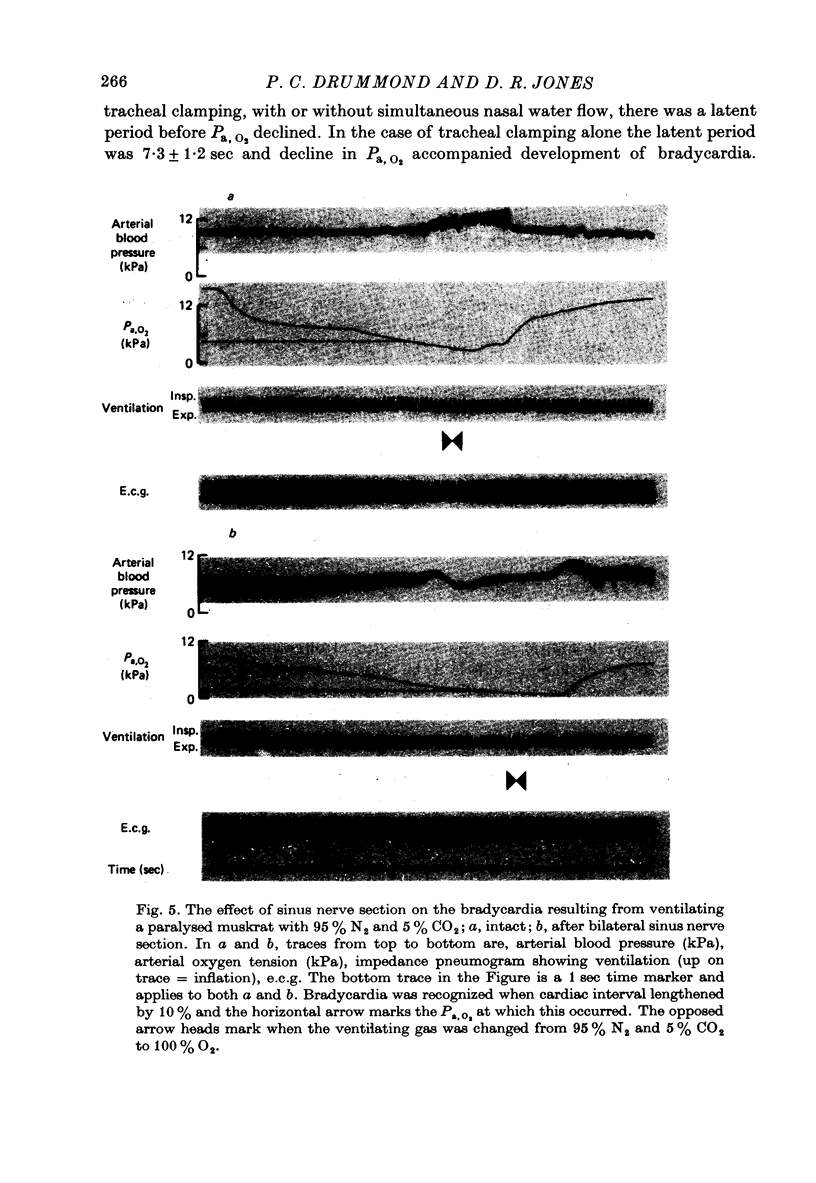





Images in this article
Selected References
These references are in PubMed. This may not be the complete list of references from this article.
- Adrian E. D. Afferent impulses in the vagus and their effect on respiration. J Physiol. 1933 Oct 6;79(3):332–358. doi: 10.1113/jphysiol.1933.sp003053. [DOI] [PMC free article] [PubMed] [Google Scholar]
- Andersen H. T., Blix A. S. Pharmacological exposure of components in the autonomic control of the diving reflex. Acta Physiol Scand. 1974 Feb;90(2):381–386. doi: 10.1111/j.1748-1716.1974.tb05599.x. [DOI] [PubMed] [Google Scholar]
- Angell-James J. E., Daly M. D. The effects of artificial lung inflation on reflexly induced bradycardia associated with apnoea in the dog. J Physiol. 1978 Jan;274:349–366. doi: 10.1113/jphysiol.1978.sp012152. [DOI] [PMC free article] [PubMed] [Google Scholar]
- Bamford O. S., Jones D. R. Respiratory and cardiovascular interactions in ducks: the effect of lung denervation on the initation of and recovery from some cardiovascular responses to submergence. J Physiol. 1976 Aug;259(3):575–596. doi: 10.1113/jphysiol.1976.sp011484. [DOI] [PMC free article] [PubMed] [Google Scholar]
- Blix A. S., Gautvik E. L., Refsum H. Aspects of the relative roles of peripheral vasoconstriction and vagal bradycardia in the establishment of the "diving reflex" in ducks. Acta Physiol Scand. 1974 Feb;90(2):289–296. doi: 10.1111/j.1748-1716.1974.tb05591.x. [DOI] [PubMed] [Google Scholar]
- DALY M. D., HAZZLEDINE J. L. THE EFFECTS OF ARTIFICIALLY INDUCED HYPERVENTILATION ON THE PRIMARY CARDIAC REFLEX RESPONSE TO STIMULATION OF THE CAROTID BODIES IN THE DOG. J Physiol. 1963 Oct;168:872–889. doi: 10.1113/jphysiol.1963.sp007228. [DOI] [PMC free article] [PubMed] [Google Scholar]
- DAVIS H. L., FOWLER W. S., LAMBERT E. H. Effect of volume and rate of inflation and deflation on transpulmonary pressure and response of pulmonary stretch receptors. Am J Physiol. 1956 Dec;187(3):558–566. doi: 10.1152/ajplegacy.1956.187.3.558. [DOI] [PubMed] [Google Scholar]
- DE DALY M. B., SCOTT M. J. The effects of stimulation of the carotid body chemoreceptors on heart rate in the dog. J Physiol. 1958 Nov 10;144(1):148–166. doi: 10.1113/jphysiol.1958.sp006092. [DOI] [PMC free article] [PubMed] [Google Scholar]
- Daly M. B., Korner P. I., Angell-James J. E., Oliver J. R. Cardiovascular-respiratory reflex interactions between carotid bodies and upper-airways receptors in the monkey. Am J Physiol. 1978 Mar;234(3):H293–H299. doi: 10.1152/ajpheart.1978.234.3.H293. [DOI] [PubMed] [Google Scholar]
- Daly M. D., Robinson B. H. An analysis of the reflex systemic vasodilator response elicited by lung inflation in the dog. J Physiol. 1968 Mar;195(2):387–406. doi: 10.1113/jphysiol.1968.sp008464. [DOI] [PMC free article] [PubMed] [Google Scholar]
- De Burgh Daly M., Hazzledine J. L., Ungar A. The reflex effects of alterations in lung volume on systemic vascular resistance in the dog. J Physiol. 1967 Feb;188(3):331–351. doi: 10.1113/jphysiol.1967.sp008142. [DOI] [PMC free article] [PubMed] [Google Scholar]
- Drummond P. C., Jones D. R. Initiation of diving bradycardia in muskrats. J Physiol. 1972 Apr;222(2):165P–166P. [PubMed] [Google Scholar]
- Elsner R., Angell-James J. E., de Burgh Daly M. Carotid body chemoreceptor reflexes and their interactions in the seal. Am J Physiol. 1977 May;232(5):H517–H525. doi: 10.1152/ajpheart.1977.232.5.H517. [DOI] [PubMed] [Google Scholar]
- Elsner R., Franklin D. L., Van Citters R. L., Kenney D. W. Cardiovascular defense against asphyxia. Science. 1966 Aug 26;153(3739):941–949. doi: 10.1126/science.153.3739.941. [DOI] [PubMed] [Google Scholar]
- HOLLENBERG N. K., UVNAS B. The role of the cardiovascular response in the resistance to asphyxia of avian divers. Acta Physiol Scand. 1963 Jun-Jul;58:150–161. doi: 10.1111/j.1748-1716.1963.tb02637.x. [DOI] [PubMed] [Google Scholar]
- Hainsworth R., Jacobs L., Comroe J. H., Jr Afferent lung denervation by brief inhalation of steam. J Appl Physiol. 1973 May;34(5):708–714. doi: 10.1152/jappl.1973.34.5.708. [DOI] [PubMed] [Google Scholar]
- James J. E., Daly M. de B. Cardiovascular responses in apnoeic asphyxia: role of arterial chemoreceptors and the modification of their effects by a pulmonary vagal inflation reflex. J Physiol. 1969 Mar;201(1):87–104. doi: 10.1113/jphysiol.1969.sp008744. [DOI] [PMC free article] [PubMed] [Google Scholar]
- James J. E., De Burgh Daly M. Reflex respiratory and cardiovascular effects of stimulation of receptors in the nose of the dog. J Physiol. 1972 Feb;220(3):673–696. doi: 10.1113/jphysiol.1972.sp009729. [DOI] [PMC free article] [PubMed] [Google Scholar]
- Jones D. R., Fisher H. D., McTaggart S., West N. H. Heart rate during breath-holding and diving in the unrestrained harbor seal (Phoco vitulina richardi). Can J Zool. 1973 Jul;51(7):671–680. doi: 10.1139/z73-101. [DOI] [PubMed] [Google Scholar]
- Jones D. R., Purves M. J. The carotid body in the duck and the consequences of its denervation upon the cardiac responses to immersion. J Physiol. 1970 Dec;211(2):279–294. doi: 10.1113/jphysiol.1970.sp009279. [DOI] [PMC free article] [PubMed] [Google Scholar]
- Jones D. R. Systemic arterial baroreceptors in ducks and the consequences of their denervation on some cardiovascular responses to diving. J Physiol. 1973 Nov;234(3):499–518. doi: 10.1113/jphysiol.1973.sp010357. [DOI] [PMC free article] [PubMed] [Google Scholar]
- Kooyman G. L., Campbell W. B. Heart rates in freely diving Weddell Seals, Leptonychotes weddelli. Comp Biochem Physiol A Comp Physiol. 1972 Sep 1;43(1):31–36. doi: 10.1016/0300-9629(72)90465-3. [DOI] [PubMed] [Google Scholar]
- Lopes O. U., Palmer J. F. Proposed respiratory 'gating' mechanism for cardiac slowing. Nature. 1976 Dec 2;264(5585):454–456. doi: 10.1038/264454a0. [DOI] [PubMed] [Google Scholar]
- Stromme S. B., Blix A. S. Indirect evidence for arterial chemoreceptor reflex facilitation by face immersion in man. Aviat Space Environ Med. 1976 Jun;47(6):597–599. [PubMed] [Google Scholar]
- Tchobroutsky C., Merlet C., Rey P. The diving reflex in rabbit, sheep and newborn lamb and its afferent pathways. Respir Physiol. 1969 Dec;8(1):108–117. doi: 10.1016/0034-5687(69)90048-6. [DOI] [PubMed] [Google Scholar]
- de Burgh Daly M., Elsner R., Angell-James J. E. Cardiorespiratory control by carotid chemoreceptors during experimental dives in the seal. Am J Physiol. 1977 May;232(5):H508–H516. doi: 10.1152/ajpheart.1977.232.5.H508. [DOI] [PubMed] [Google Scholar]
- de Burgh Daly M. Interaction of cardiovascular reflexes. Sci Basis Med Annu Rev. 1972:307–332. [PubMed] [Google Scholar]





